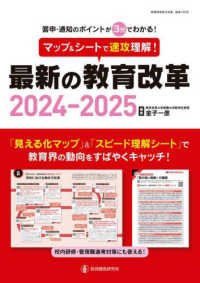- ホーム
- > 洋書
- > 英文書
- > History / World
Full Description
Modern-day Aldborough, in North Yorkshire, lies on the site of Isurium Brigantum, the former administrative capital of the Brigantes, one of the largest indigenous tribes of Roman Britain. Strategically located on Dere Street, by the second century AD it had become a key Roman town engaged with the supply of the northern frontier, with buildings and mosaics that reveal a thriving economy through to the fourth century.
In the eighteenth and nineteenth centuries, the site of Isurium Brigantum was the subject of important antiquarian investigations. However, unlike some southern counterparts - for example, Calleva Atrebatum or Verulamium - in the twentieth century it attracted less archaeological attention. Then, in 2009 a team of archaeologists led by Dr Rose Ferraby and Professor Martin Millett began a major re-examination of the site. This included large-scale geophysical surveys using both gradiometry and high-resolution ground-penetrating radar. Most of the town and its surroundings were revealed, allowing its development from the second century AD to the medieval period to be mapped with great accuracy.
Brought together in this volume for the first time are the results of those surveys, together with a re-evaluation of the earlier antiquarian work and more recent archaeological fieldwork and excavations - some never before published. The resulting volume provides historians and archaeologists with exciting new information about the topography and development of the Roman town and later landscape, together with a thorough review of the town in the broader context of Roman Britain and the western Empire.
The volume is complemented by an interactive digital archive, which is free to access.
Contents
List of figures
Preface
Resume
Zusammenfassung
Acknowledgements
Notes on referencing and archives
Chapter 1: Introduction
Background to this study
Geographical setting
Historical background
Previous inferences on urban origins
Textual evidence
History of the town
Previous archaeological work
Organisation of this volume
Chapter 2: Previous antiquarian and archaeological work
Knowledge up to the mid eighteenth century
The later eighteenth century
The first half of the nineteenth century
From the 1850s to the 1920s
Excavations of the 1920s and 1930s
The 1940s to the 1980s
The 1990s onwards
Chapter 3: The geophysical surveys
Introduction
Methodology
Presentation of the results
Area 1: North-western intra-mural area
Area 2: North-eastern intra-mural area
Note on terracing in the southern half of the town
Area 3: Central intra-mural strip
Area 4: South-western intra-mural area
Area 5: South-eastern intra-mural area
Area 6: South-eastern extra-mural area
Area 7: Eastern extra-mural area
Area 8: South-eastern extra-mural area
Area 9: Northern extra-mural area
Area 10: Northern extra-mural area beside the river
Area 11: The northern bridgehead
Area 12: The western extra-mural area
Area 13: The south-western extra-mural area
Chapter 4: Re-evaluating the history of Isurium Brigantum
The Iron Age background
The Roecliffe fort
Earliest activity on the site of Aldborough
Town planning
The forum and the establishment of the civitas
The Town Wall
The character of the early to mid Roman town
The development of the extra-mural areas
The later Town Wall and annexes
The later Roman townscape
The transition to the Middle Ages
Epilogue: history, antiquarian development and landscape
Appendix 1: Gazetteer of archaeological interventions
Appendix 2: Concordance with RIB
Appendix 3: Concordance with CSIR
Appendix 4: Architectural stonework
Appendix 5: Stone altars
Notes
Abbreviations and bibliography
Index






